West Virginia is home to various native bird species noted for their gorgeous mountains and rolling hills. In West Virginia, over 366 distinct bird species may be spotted at various times of the year.
The Northern Cardinal, including its unique color and singing, maybe seen all year in West Virginia. Also, it is known to be the official state bird of West Virginia.
| Image | Name |
|---|---|
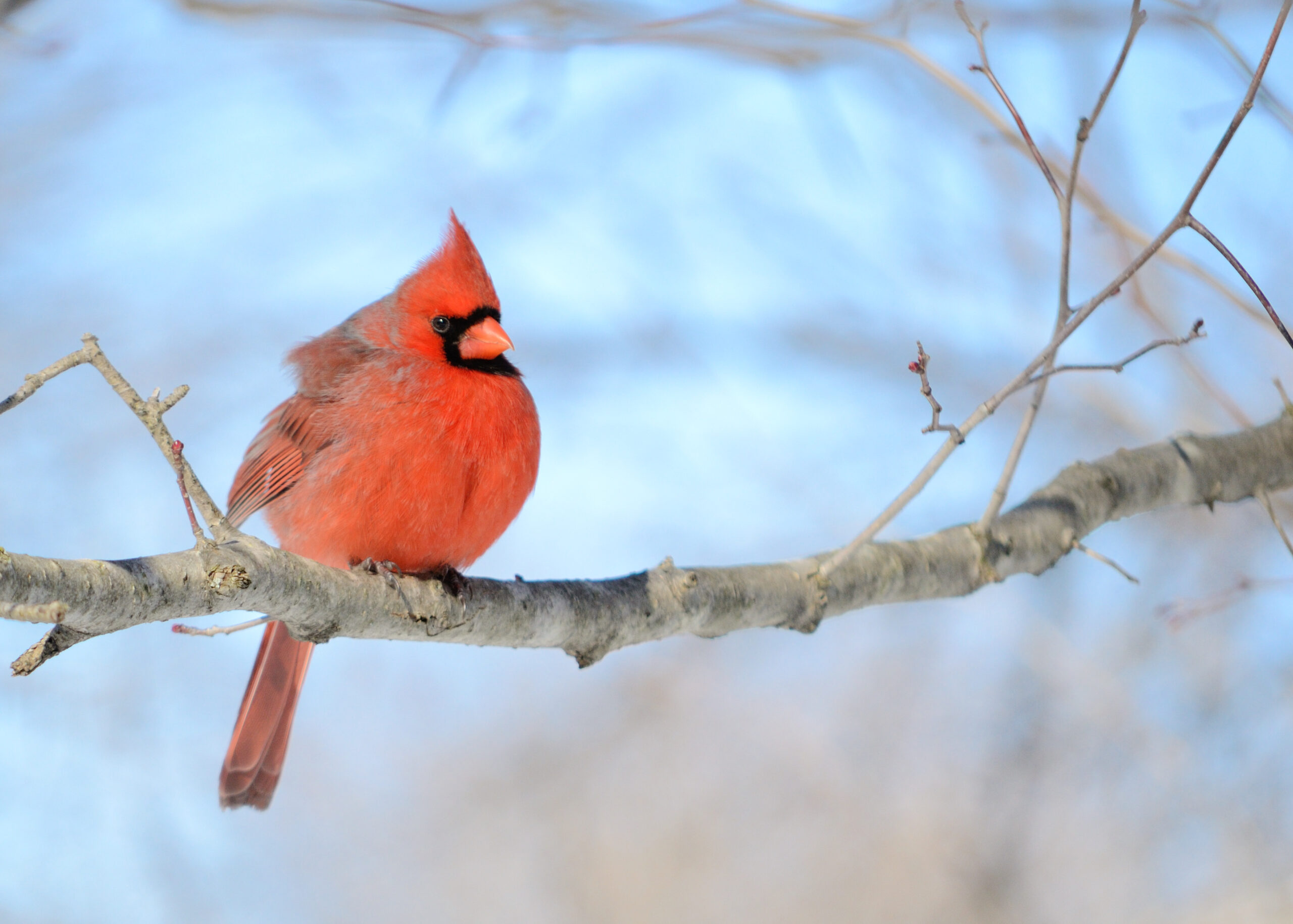 | Northern Cardinal |
 | Blue Jay |
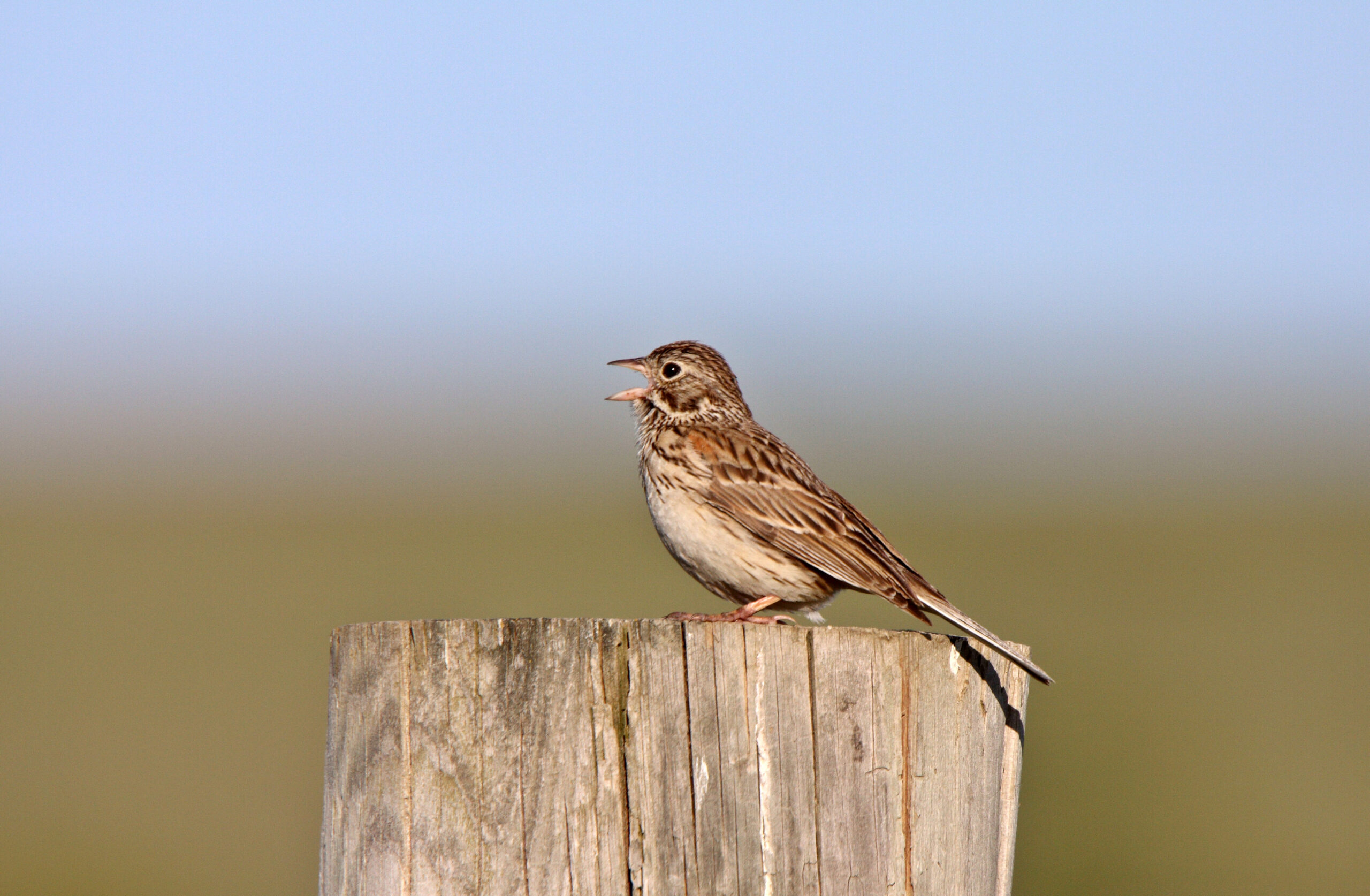 | Song Sparrow |
 | American crow |
 | Carolina Chickadee |
 | European Starling |
 | Common Yellowthroat |
 | Tree Swallow |
 | Downy Woodpecker |
 | Eastern Towhee |
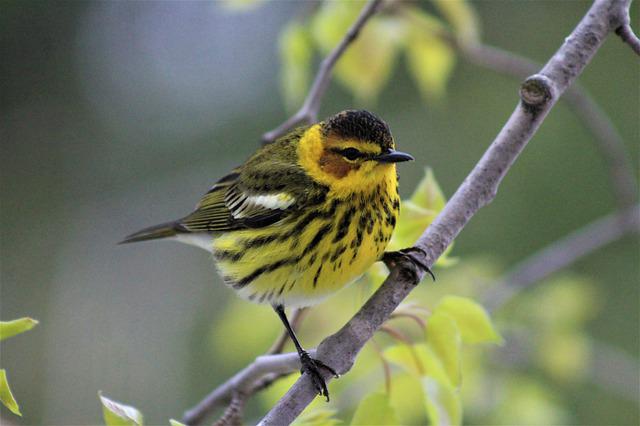 | Cape May Warbler |
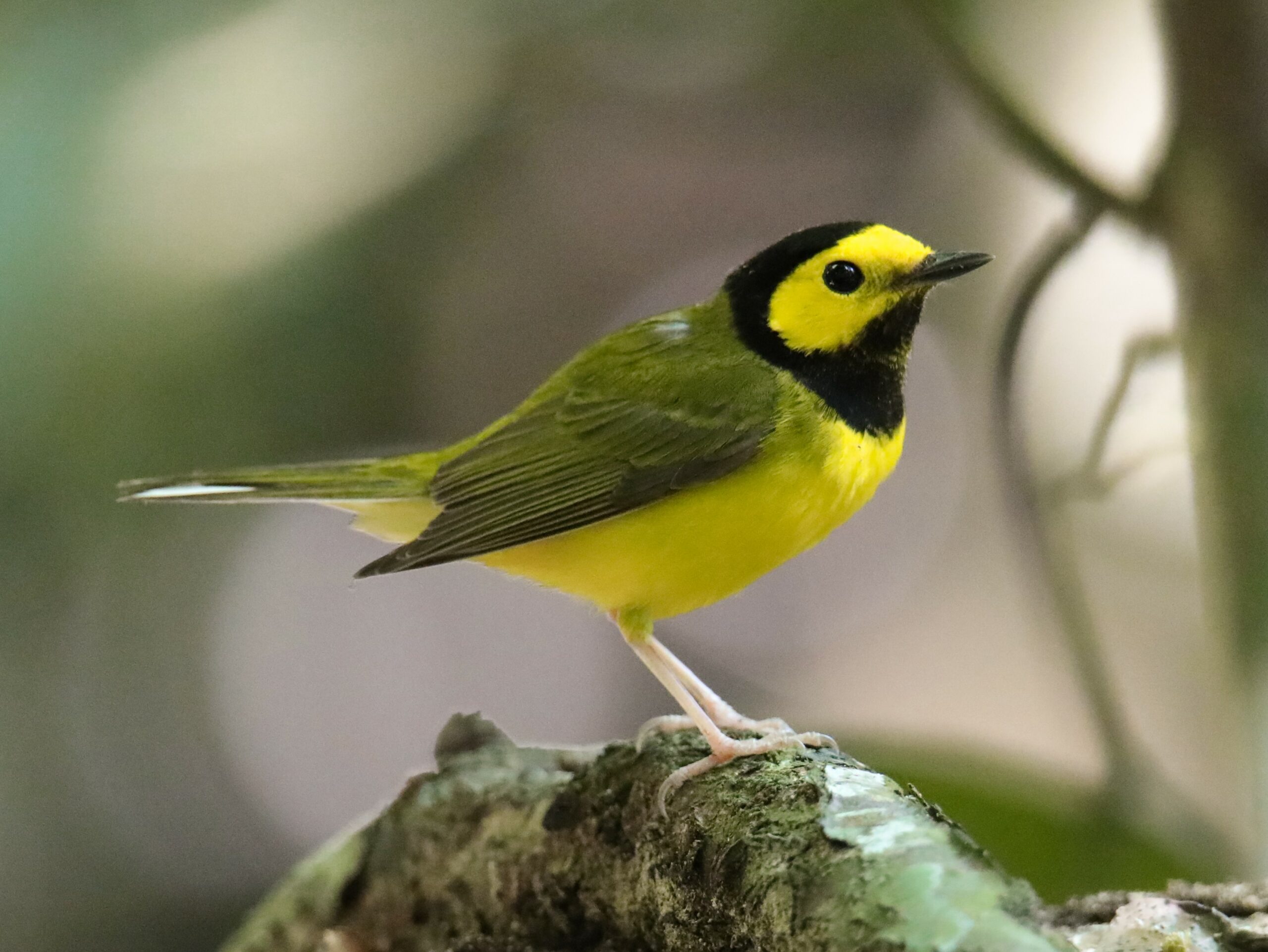 | Hooded Warbler |
 | Evening Grosbeak |
 | Summer Tanager |
 | Tufted Titmouse |
 | Purple Finch |
 | American Goldfinch |
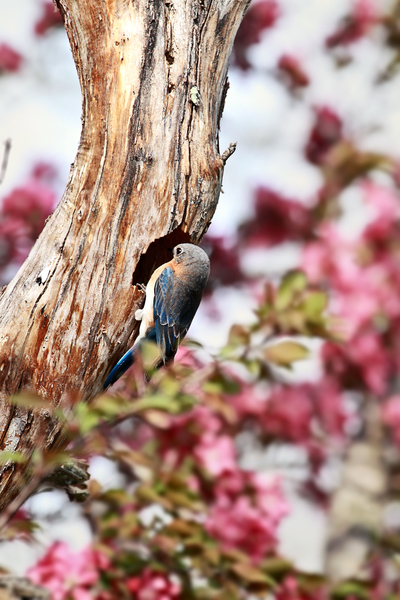 | Eastern Bluebird |
 | Red-bellied Woodpecker |
Common Birds in West Virginia
1. Northern Cardinal

North Cardinal is common in the Southeast, but it’s been expanding its territory northward for years, and it now graces winter days much further north as south-eastern Quebec with its beauty and whistled melody.
Sunflower seed feeders may have helped its northward expansion. These birds forage primarily on the grass or in low shrubs, with occasional foraging higher in trees. It is a frequent visitor to feeders, in which it prefers sunflower seeds.
Food
Seeds, insects, and berries are the most common. The diet is fairly diverse. Beetles, real insects, crickets, larvae, ants, flies, and a variety of other insects and spiders, centipedes, and snails are among the creatures it eats.
Vegetable matter makes up the majority of the diet, including weed and grass seeds, wasted wheat, floral, and a variety of fruit and wild fruits. Their primary dietary needs are fulfilled by feeding on insects.
2. Blue Jay

Blue jays are woodland dwellers by nature, but they’re also adaptive.
Oak trees, nuts, and seeds make up the majority of their food, although they also consume larvae, grasshoppers, and bugs. Acorns are occasionally stored in the nests of blue jays.
Blue jays are found over most of eastern and central North America, and their range is steadily expanding towards the Northwest. They tend to Forage on the ground as well as in trees and plants. Seeds or suet attract them. To crack open hard nuts or seeds, these birds pound them with a bill.
3. Song Sparrow

Song Sparrows are standard size sparrows with a robust appearance. The bill is small and robust, and the head is quite rounded for a sparrow. The wings are large, and the tail is lengthy and rounded. Song Sparrows have strong stripes on their white breast.
Habitat
Song sparrows can be found mostly on the ground, occasionally digging in the earth to find food. Moreover, they forage in shallow water and high up in bushes and trees on occasion. Bird feeders placed near decent cover will attract them.
Food
These birds eat a wide variety of invertebrates in the summer and fruits and seeds throughout the year. Larvae, leaf bugs, caterpillars, damselflies, crickets, moths, spiders, and worms are some of the creatures that they eat.
4. American Crow

The American crow is widespread in the United States. Males and females appear to be identical on the outside. They have long tails and wings and lengthy and stout black beaks with a noticeable bend on the upper bill that is straight but has a noticeable curve on the lower bill. These birds are huge, measuring 15.8–20.9 inches long and 33.5–39.4 inches in wingspan.
Habitat
The optimal habitat for American crows is a combination of open fields with food and woodlots with trees for breeding and roosting. While the female incubates the eggs, the adult and nest partners feed her. They normally relocate in late fall or early winter.
Food
Bugs, beetles, nuts, fruits, carcasses, tiny animals, salmon, and hatchlings from other nests, particularly carrion chicks, are consumed by these crows.
5. Carolina Chickadee

These birds have grey backs, medium-length grey wings, and long, thin grey tails with white below. Excluding a little black bib, they have a white underside and chest, as well as a white face. The beaks of these birds are short, thick, and triangular in shape.
Length
These little beauties are 3.9 – 4.7 inches long, with wingspans ranging from 5.9 to 7.9 inches broad.
Habitat
Carolina Chickadee is said to be a visitor at bird feeders in milder regions but does come into residential yards seeking sunflower seeds.
Seeds or Suetsuet are attracted to bird feeders. Bugs, seeds, and berries are the most common. It likely consumes more vegetative matter than in the summer or the winter.
In the summer, caterpillars make up a large part of the diet, but it also eats larvae, bugs, beetles, aphids, and a variety of other bees and wasps. Nuts, cherries, and small fruits are ingested as well.
These creatures have the potential to mate for the remainder of their lives. The most common time for pairs to develop is during the winter, and they stay together throughout the season.
The nest is in a hole in the tree, which is frequently an extension of a small natural hole in deadwood or an old pecking burrow or nesting box and is normally 5-15 feet above the ground. Both sexes assist in excavating or enlarging the inside of a natural hole.
6. European Starling

European Starlings have two unique feather patterns, one for summer and one for winter. When the weather is warm, they appear to be typical Blackbirds from a distance, but up close, their plumage is a blend of purples and greens that are highly lustrous and gorgeous.
These species have lengthy, straight yellow bills, which might help you identify them from afar until you become accustomed to seeing them. In the winter, they switch to their second color scheme, with a brow plumage that is enhanced with exquisite white patches.
Food
These birds have lived near people for decades. Grains, dried oat, and crushed peanuts are favorites of these birds.
7. Common Yellowthroat

The Common Yellowthroat, commonly known as Geothlypis trichas, is a little new world warbler from the Parulidae family of birds. They can be seen in big groups over North America. It seems to have a lime neck, as the name indicates.
The Common Yellowthroat has pale yellow to greenish-yellow feathers all over its body. A black streak runs first from the snout to the eyelids and towards the rear of the head of the Common Yellowthroat bird. The back of the Typical Yellowthroat bird is olive-colored.
The bird’s wings and upper body are entirely coated in a greenish-yellow tint. The Common Yellowthroat male and female are a bit better than each other.. Males and females may readily be distinguished and classified into two sexes as a result of this.
Size
The typical body length of a Common Yellowthroat is 11-13 cm, with a wingspan of almost 15-19 cm.
The typical weight of a Common Yellowthroat is around 9-10 g. In pursuit of food, the bird scavenges in tree branches and on the ground.
Food
Nuts, leafy fruits, berries, and nuts are their main sources of nutrition. Larvae, spiders, and beetles are among the tiny insects that the Common Yellowthroat bird consumes.
8. Tree Swallow

The Tree Swallow also called the Tochilinite multicolor, is a little North American bird that is notable for its wood chipping behavior.
The Tree Swallow is a gorgeous bird with blue and white feathers. Their plumage is separated into two colors: a sparkling blue upper body and wings and a white abdomen and underparts. The bird’s eyes and tail are both black in color.
The male and female have different shades, forms, sizes, and weights. Males have far more gleaming black, blue, and white plumage than female Tree Swallows. In terms of height, mass, and wingspan, females are slightly smaller than males. A migratory bird, the Tree Swallow, migrates from one site to another.
Food
They eat from the bird tables in their region of stay on a regular basis. Seedlings and nuts, as well as berries and fruits, are favorites. This bird also feeds on tiny insects and worms, as well as insect larvae.
9. Downy Woodpecker

Downy Woodpeckers also have broad white swath over their backs, as well as lengthy, black wings with separated stripe designs thought up of cylindrically white patches.
They have little tails that are black on top and white on the bottom, as well as a pristine white underbelly and breast. These birds have needle-nose pliers-like bills that are slender and medium in length. These are the tiniest woodpeckers in North America, reaching 5.5–6.7 inches long and 9.8–11.8 inches in wingspan.
Habitat
These birds prefer deciduous woodlands, particularly when there is brush cover nearby, although they may also be seen foraging in fields. When foraging, they like to descend from trees straight into the thick grass and eat, which is quite a sight to watch.
Food
These birds are typically seen in orchards and backyards with very well feeders, but they may also be found in fruit trees, parklands, and back gardens. The Downy Woodpecker prefers raw peanuts and Suet, particularly fruit-blend Suet.
10. Eastern Towhee

These birds have a strong, medium-length, conical black beak and typically have crimson eyes. The length of these birds ranges from 6.8 to 8.2 inches, with wingspans ranging from 7.9 to 11 inches. Brushes, shrubs, brambles, and thorns are home to Eastern Towhees.
Black backs, tiny black wings, and long black tails distinguish Eastern Towhees. The plumage will contain white accents on the wings and tail, although it will be scarce. This bird has a brownish-red breast and underbelly with a white breast and underbelly.
Oil in the color of black Sunflowers seeds, White millet, and smashed peanuts may all be used to attract Eastern Towhees to a backyard feeder.
11. Cape May Warbler

This bird quite has a mustard face with an olive head and a narrow, olive eyeliner that is underlined by a strong, curved brown line. The bills of these birds are narrow, medium-length, black, and straight, with a little curvature on the top bill. Females and youngsters will have a more subdued coloring, with yellow-green rumps.
The backs of Cape May Warblers are olive-grey and yellow, with medium-length wings and small tails. While the rear of this bird is grey-white with such a hint of yellow, the underside and chest will be a combination of rich yellows, with some faint white and ‘tiger stripe’ olive streaking throughout.
Length & Habitat
These little birds have wingspans of about 7.9 inches and are 4.5 inches in length. These birds like to spend all their time in coniferous woods during mating season, but they may be found almost everywhere there is deep cover in the shape of shrubs, undergrowth, high grasslands, or shrubs after that.
Food
The Cape May Warbler is easily enticed by grape jelly and genuine grapes.
12. Hooded Warbler

This bird’s underside and breast are a bright yellow, but they have a black hood that v’s into the breast. However, the center of their mouth will be bright yellow. Their black eyes stand out, and their bills are long, slender, and straight.
The Hooded Warbler is a species of warbler that lives in the backs of hooded warblers are olive green, with short olive and grey wings and long grey tails with certain white outer plumes.
Length & Habitat
These little birds are around 5.1 inches long from stem to stern and have wingspans of 6.9 inches wide on average. Hooded Warblers can be located in any woodland with sufficient shrub cover. When feasible, they prefer older deciduous trees.
Food
Although these birds prefer to eat insects and rarely visit feeders, you may sometimes entice them in by putting very little Suetsuet on the tree’s bark and dangling a suet feeder, cage, or another sort nearby.
13. Evening Grosbeak
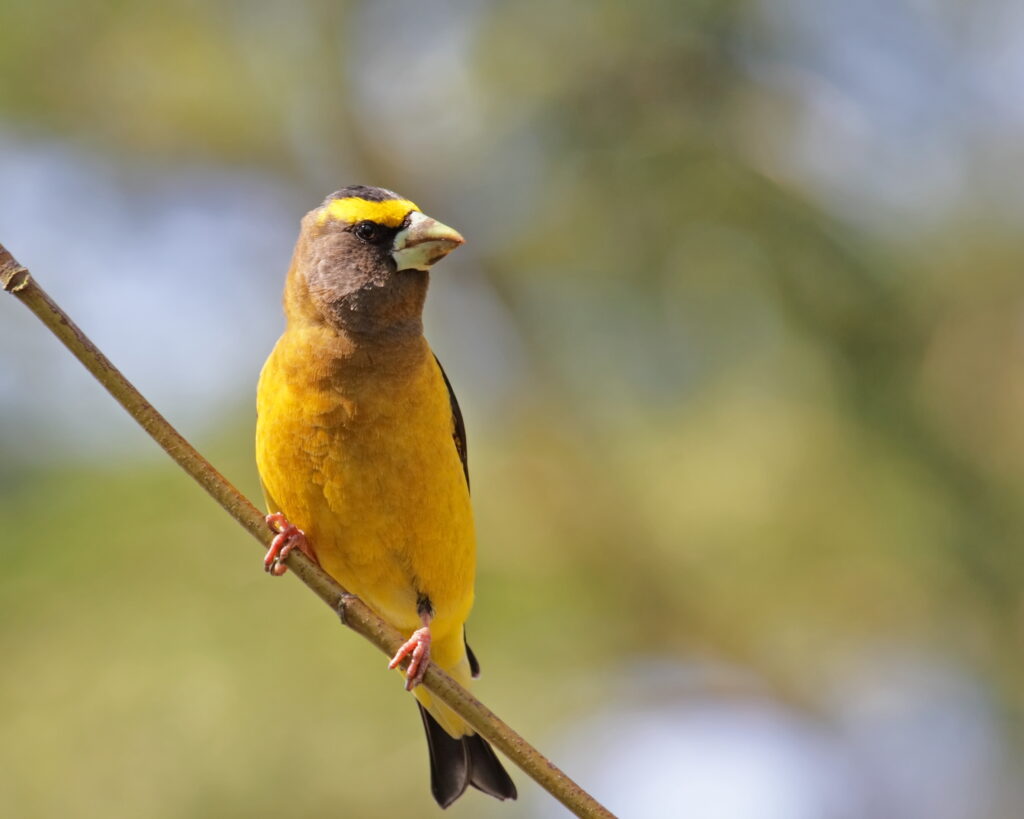
The backs of grosbeaks are olive, having a yellow shoulder on their broad, black wings. A big white spot is also visible, forming a shield-like appearance while the bird is resting.
They have little black-tailed with certain yellow on the underparts, and this bird’s underbelly and breast are also a ‘dirty’ yellow tint. They have brown heads with lighter color saturation towards the cheeks, blackcaps, and a wide yellow stripe across each eye on their faces.
The beak of these birds is huge, thick, and conical golden ‘aged-ivory.’ Females and youngsters will have soft grey tops and paler bottoms, white-patched black wings, and a greenish-yellow collar. The length of these birds ranges from 6.3 to 7.1 inches.
Habitat
These birds like deciduous and coniferous woodlands, usually at higher altitudes, but they may be found in a wide variety of habitats and are regular visitors to backyard feeders at this time of year.
Food
Evening Grosbeaks are likely to persuade; simply put out a few Black Oil Pumpkin seeds and some suet, and you’re ready to welcome them as guests.
14. Summer Tanager

Male Summer Tanagers have beautiful plumage and are easy to see. They are totally crimson, with medium-length wings and long, bouncy tails. Females and youngsters have contrasting colors on their faces, with broad and sturdy pale bills.
They’ll have golden-yellow plumage with a yellowish-green face and more green on the rear and wings. The length of these birds is around 6.7 inches from head to tail, and their wingspans are about 12 inches broad.
Habitat & Food
These birds prefer wide woodlands, especially those with a mix of deciduous pine and oak trees. Search for them here, particularly if there are any local streams or rivers since these birds enjoy being near water. Peanuts oil, cornmeal, and Suet are favorites of these birds.
15. Tufted Titmouse

They are related to chickadees, but they have a crest instead of a black bib. Tufted Titmice may be seen year-round in West Virginia. This species, smaller than chickadees but larger than a mourning dove, is a little bird but a giant titmouse.
The body is rounded, the tail is long and full, the head is large, and the legs are lengthy. Short and stocky, dark, compressed. Above, it’s a dark blue-grey, and below, it’s a faint blue-grey.
Habitat
The black feathers around it emphasize the size of the eye. Lives in parks and deciduous woodlands with a dense canopy. Its distribution is increasing north and west, with origins in the south-eastern United States.
Backyard bird feeders may be assisting this species’ northward expansion. Insects and seeds are two of the most common types of insects. They prefer black oil seeds and Suetsuet in your feeder or tray feeder.
16. Purple Finch

They have medium-length wings and small, notched tails, with reddish pink and brown backs. Both wings are dark and reddish-pink in color, with two thin white wing bars on each wing. The back is white, but the underside is white with pink streaks and becomes a strong saturation of pinkish-red hue as it gets closer to the breast.
This bird’s face is predominantly a pale raspberry color. Female Purple Finches lack raspberry coloration. However, they have an olive top with a white breast and underbelly. A dark, olive line can also be seen running from the beak to the neck.
These birds have sturdy, medium-length conical bills that are pinkish-yellow, and there is a little black on the tips of it.
Food
Seeds, blooms, cherries, and insects are all edible. In the winter, it eats mostly seeds, including those from trees. It also consumes the buds of a variety of trees, as well as berries and tiny fruits.
During the summer, it eats invertebrates such as moths and bugs. Seeds may be the primary source of nutrition for the young.
17. American Goldfinch
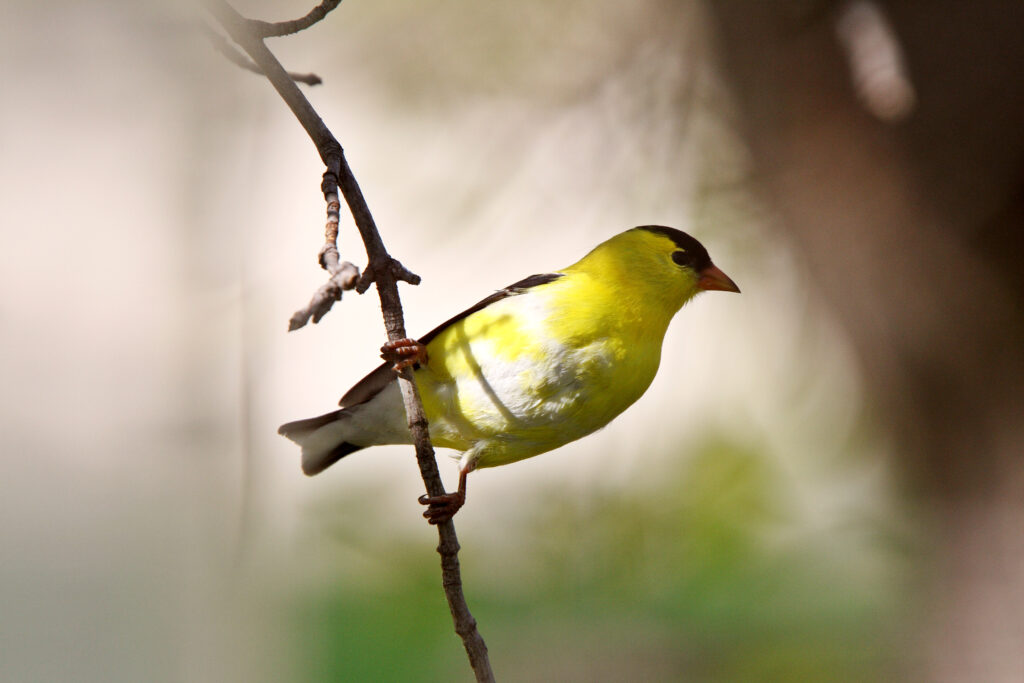
These birds have brilliant yellow backsides and lengthy black wings with two white wing bars and vertical white lines towards the lower-center area of the inner wing. They have white rumps and short, notched tails with white patterns on top.
The length of these birds ranges from 4.3 to 5.1 inches, with wingspans of 7.6 to 8.7 inches.
Habitat & Food
These birds like overgrown fields, especially those that are prone to flooding, and hence provide excellent feeding opportunities. They can be seen in fields, gardens, and backyards on a regular basis. A combination of peanut butter and suet cake is loved by these birds.
18. Eastern Bluebird

Eastern Bluebird males have beautiful deep blue backs, long blue wings, and short blue tails. The rear is pure white, but the underside and breast will have an orange-brown border that rises in intensity at the chest, continues up into the throat, and then ends horizontally right beyond the shoulders.
With the exception of a grey chin, the rest of the face is blue. They have softly curved black or silvery bills. The length of these birds ranges from 6.3 to 8.3 inches, with wingspans ranging from 9.8 to 12.6 inches.
Habitat & Food
These birds like open woodland settings like pastures, hillsides, and bushland. They’re also very susceptible to nesting boxes. Suet, chopped apples, and Black Oil Sunflower seeds are liked by these birds.
19. Red-bellied Woodpecker

These birds have lengthy wings and short, sturdy tails, and they exhibit a remarkable Zebra-stripe pattern. This bird’s chest and underside are white with red streaks, as well as a characteristic red mark on the belly.
This bird’s head is predominantly white, with a red cap that runs down to the back of the neck and some streaks of red around the cheeks. The beaks of these birds are large, robust, and straight black.
The average length of these birds is 9.4 inches, with wingspans ranging from 13 to 16.5 inches. They’re brash birds who like to fly about a lot and frequent backyard feeders.
Food
Oil in the color of black Sunflowers seeds, suet, and grape jelly are amongst their favorite meals.
Final Words
Thus West Virginia is home to many valuable species of birds. You may find them foraging playing singing in different habitats. Few of them are very witty and intelligent, just like American crows, and some even enjoy eating from feeders’ hands.
FAQ
What is the state bird of West Virginia?
Northern Cardinal. It is the state bird of West Virginia.
Which birds migrate to West Virginia in winters?
Snow goose, Tundra swan, Read head, Northern pintail, etc
Which is the most commonly found bird in West Virginia?
Northern Cardinal is widespread in West Virginia.
Last Updated on March 22, 2023 by Lily Aldrin
